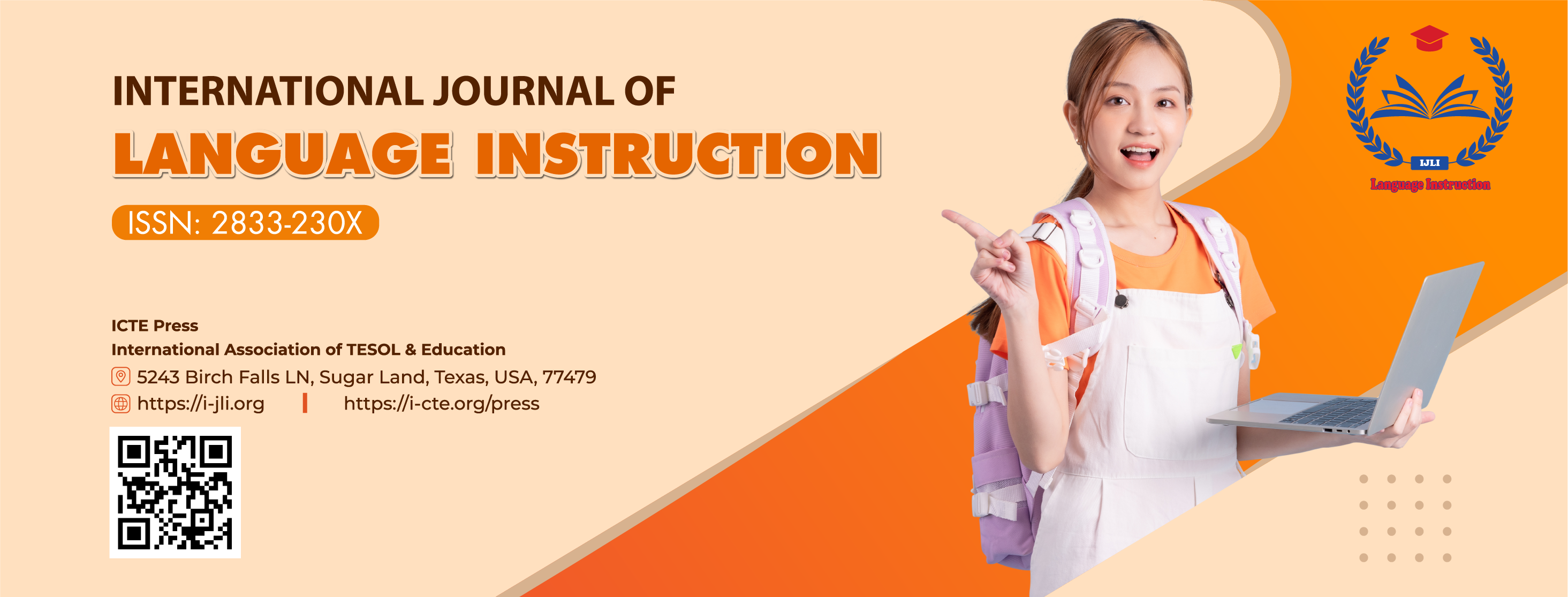An Analysis of Coherence and Cohesion in English Majors’ Academic Essays
DOI:
https://doi.org/10.54855/ijli.24331Keywords:
coherence, cohesion, error analysis, essay writing, higher educationAbstract
This research investigates coherence (how ideas are logically connected) and cohesion (how sentences flow together) errors in essays written by junior English majors. Analyzing 80 essays and conducting 10 interviews, the researchers identified common errors and usage patterns. Using Halliday and Hasan’s (1976) framework for cohesion and Oshima and Hogue's (2006) framework for coherence, the findings reveal frequent use of lexical cohesion, such as repetition and synonyms, but also misuse of cohesive devices. The study suggests that clear instructional interventions should be developed to improve writing skills, and regular feedback should be provided. Teachers should demonstrate the use of cohesive devices to connect ideas and enhance coherence and peer review activities can also help students learn from each other's writing. Future research should consider longitudinal studies and cross-institutional comparisons to track progress and identify common issues.
References
Ahmad, M., Mahmood, M. A., & Siddique, A. R. (2019). Organisational skills in Academic Writing: A study on coherence and cohesion in Pakistani research abstracts. Languages, 4(4), 92. https://doi.org/10.3390/languages4040092
Ahmed, F. E. Y. (2019). Errors of unity and coherence in saudi arabian EFL university students’ written paragraph - a case study of college of science & arts, Tanumah, King Khalid University, Kingdom of Saudi Arabia. Journal on English Language Teaching. https://doi.org/10.46827/ejel.v0i0.2281
Alqasham, F. H., Al-Ahdal, A. A. M. H., & Babekir, A. H. S. (2021). Coherence and cohesion in Saudi EFL Learners’ Essay Writing: A study at a tertiary-level institution. ResearchGate. https://www.researchgate.net/publication/349256060
Aminovna, B. D. (2022). Importance of coherence and cohesion in writing. Eurasian Research Bulletin, 4, 83-89. https://geniusjournals.org/index.php/erb/article/view/431/373
Bailey, S. (2003). Academic Writing: A Practical Guide for Students. New York: Routledge.
Bui, P. H., Nguyen, N. Q., Loc, T. N., & Nguyen, T. V. (2021). A Cross-Linguistic Approach to Analysing cohesive devices in expository writing by Asian EFL teachers. Journal of Language Teaching, Linguistics and Literature, 27(2), 16–30. https://doi.org/10.17576/3l-2021-2702-02
Cambridge IELTS (2019). Cambridge IELTS 14 academic: Authentic Practice Tests. Cambridge: Cambridge Press and UCLES.
Do, N. H. M., & Le, Q. T. (2023). Lexical Collocation Errors in Essay Writing: A Study into Vietnamese EFL Students and Their Perceptions. International Journal of Language Instruction, 2(2), 1-20. DOI: https://doi.org/10.54855/ijli.23221
Farida, A. N., & Arifin, I. (2020). Cohesion and coherence in the final project abstracts written by undergraduate students. ELT Forum: Journal of English Language Teaching, 9(2), 25–33. https://doi.org/10.15294/elt.v9i2.37785
Hasyim, S. (2002). Error analysis in the teaching of English. K@Ta: A Biannual Publication on the Study of Language and Literature, 4(1), 62–74. https://doi.org/10.9744/kata.4.1.62-74
Halliday, M. A. K., & Hasan, R. (1976). Cohesion in English (No. 9). Routledge.
Halliday, Μ. Α. Κ., & Hasan, R. (1989). Language, Context, and Text: Aspects of Language in a Social-Semiotic perspective. TESOL Quarterly, 21(2), 353. https://doi.org/10.2307/3586740
Halliday, M., & Matthiessen, C. (2004). An introduction to functional grammar. Routledge.
Has, S.A.Y. (2021). An analysis of cohesion and coherence in the background of the Skripsi of English education program in State Islamic Institute (Iain) Parepare. https://repository.iainpare.ac.id/id/eprint/3694/1/15.1300.007.pdf
Hedge, T. (2005). Writing. Oxford University Press.
Ingemann, F., & Crystal, D. (2008). A Dictionary of Linguistics and Phonetics. https://doi.org/10.1002/9781444302776
Ho, T. L. U. (2024). Problems with Academic Writing Encountered by EFL Postgraduate Students at a University in the Mekong Delta. International Journal of Language Instruction, 3(1), 1-16. DOI: https://doi.org/10.54855/ijli.24311
Kafes, H. (2012). Lexical Cohesion: An Issue only in the Foreign Language? English Language Teaching, 5(3), 83-94. https://doi.org/10.5539/elt.v5n3p83
Kuo, C. (1995). Cohesion and coherence in Academic writing: From lexical choice to organization. RELC Journal, 26(1), 47–62. https://doi.org/10.1177/003368829502600103
Lismay, L. (2020). Analysis of Coherence and Cohesion on Students' Academic Writing: A Case Study at the 3rd year students at English Education Program. Alsuna, 3(2), 74–82. https://doi.org/10.31538/alsuna.v3i2.980
Maria, K. (2015) Academic English- Section 3: Coherence – Cohesion in Writing. Hellenic Republic, University of Crete. School of Sciences and Engineering.
McNamara, D. S., Crossley, S. A., & McCarthy, P. M. (2010). Linguistic features of writing quality. Written Communication, 27(1), 57–86. https://doi.org/10.1177/0741088309351547
Mojica, L. A. (2006). Reiterations in ESL learners’ academic papers: Do they contribute to lexical cohesiveness. The Asia-Pacific Education Research, 15(1), 105-125. DOI: https://doi.org/10.3860/taper.v15i2.83
Moxley, K. (2015). Cohesion in Writing. FHS Writing Lab. https://ched.uct.ac.za/sites/default/files/content_migration/ched_uct_ac_za/1072/files/Cohesion.pdf
Muluk, S., Zainuddin, Z., & Dahliana, S. (2022). Flipping an IELTS Writing Course: Investigating its impacts on students’ performance and their attitudes. Studies in English Language and Education, 9(2), 591-612. https://doi.org/10.24815/siele.v9i2.23314
Noori, A. (2020). An Investigation of Afghan Undergraduate English Major Students Academic Writing Difficulties. Journal of Foreign Language Teaching & Learning, 5(2), 99-114. https://doi.org/10.18196/ftl.5249
Oanh, H., & Huynh, T. (2023). Cohesion errors in argumentative essays committed by third- year english-majored students at Thu Dau Mot University, Vietnam. International Journal Of Education And Pedagogy, 5(1), 74-86. https://myjms.mohe.gov.my/index.php/ijeap/article/view/21515/11729
Oller, J. W., & Jonz, J. (1994). Cloze and coherence. Associated University Press.
Ong, J. (2011). Investigating the use of cohesive devices by Chinese EFL learners. Asian EFL Journal, 13(3), 42–65.
Putra, P. P., & Astari, Y. (2022). Analysis of cohesion and coherence in the background of thesis written by English education study program students of IAIN Bengkulu in period September 2020. BRIGHT: A Journal of English Language Teaching, Linguistics and Literature, 5(1), 79-90.
Rahman, Z. A. A. A. (2013). The use of cohesive devices in descriptive Writing by Omani Student-Teachers. SAGE Open, 3(4), 215824401350671. https://doi.org/10.1177/2158244013506715
RahmtAllah, E. A. E. (2020). EFL Students’ coherence Skill in writing: A case study of third year students of Bachelors in English Language. English Language Teaching, 13(8), 120. https://doi.org/10.5539/elt.v13n8p120
Rao, Z. (2007). Training in brainstorming and developing writing skills. ELT Journal, 61(2), 100–106. https://doi.org/10.1093/elt/ccm002
Renkema, J. (2004). Introduction to Discourse Studies. Amsterdam: John Benjamins Publishing Company. 1-469. https://www.torrossa.com/en/resources/an/5000518
Saeed, A., Everatt, J., Sadeghi, A., & Munir, A. (2022). Cognitive Predictors of Coherence in adult ESL learners’ writing. Journal of Language and Education, 8(3), 106– 118. https://doi.org/10.17323/jle.2022.12935
Sholah, H. M. (2019). Enhancing EFL learners’ writing skill via journal writing. Alsuna: Journal of Arabic and English Language 2(2), 96–116.
Suwandi, S. (2016). Coherence and cohesion: An analysis of the final project abstracts of the undergraduate students of PGRI Semarang. Indonesian Journal of Applied Linguistics, 5(2), 253. https://doi.org/10.17509/ijal.v5i2.1349
Ulla, M. B. (2014). Analysis of the language errors in writing among BSEE and AB English students. European Journal of Academic Essays, 1(3), 39-47.
Widdowson, H. G. (2007). Discourse analysis. Oxford University Press, USA.
Yang, W., & Sun, Y. (2012). The use of cohesive devices in argumentative writing by Chinese EFL learners at different proficiency levels. Linguistics and Education, 23(1), 31–48. https://doi.org/10.1016/j.linged.2011.09.004
Downloads
Published
Issue
Section
License
Copyright (c) 2024 Diep Gia Luat, Le Thi Ngoc Diep

This work is licensed under a Creative Commons Attribution 4.0 International License.
The copyright of all articles published in the International Journal of Language Instruction (ijli) remains with the Authors, i.e. Authors retain full ownership of their article. Permitted third-party reuse of the open access articles is defined by the applicable Creative Commons (CC) end-user license which is accepted by the Authors upon submission of their paper. All articles in the ijli are published under the CC BY-NC 4.0 license, meaning that end users can freely share an article (i.e. copy and redistribute the material in any medium or format) and adapt it (i.e. remix, transform and build upon the material) on the condition that proper attribution is given (i.e. appropriate credit, a link to the applicable license and an indication if any changes were made; all in such a way that does not suggest that the licensor endorses the user or the use) and the material is only used for non-commercial purposes.
Authors are able to enter into separate, additional contractual arrangements for the non-exclusive distribution of the journal's published version of the work (e.g., post it to an institutional repository, in a journal or publish it in a book), with an acknowledgment of its initial publication in this journal.











